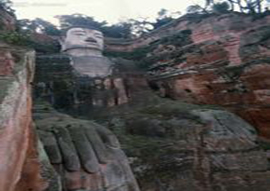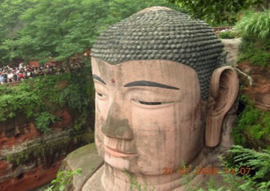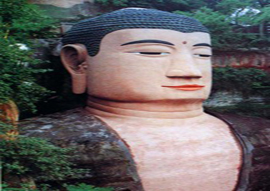Leshan Giant Buddha, the largest stone sculpture of Buddha in the world, sits at the confluence of the  Minjiang, Dadu and Qingyi rivers. According to records, the carving of this giant Buddha was begun in the in the first yea of the reign of the Tang Emperor Tang Xuanzong (713 AD), and completed in the 19th year of Emperor Dezong (803 AD), a total of 90 years. Minjiang, Dadu and Qingyi rivers. According to records, the carving of this giant Buddha was begun in the in the first yea of the reign of the Tang Emperor Tang Xuanzong (713 AD), and completed in the 19th year of Emperor Dezong (803 AD), a total of 90 years.
Taking the shape of a Maitreya ,he is depicted barefooted with drooping ears and has his hair arranged in a spiral topknot. His chest is exposed and his hands rest on his knees. Carved from the side of the Lingyun Hill, with his head level with the cliff top, the gigantic stone sculpture faces Mt. Emeishan, with the rivers flowing below his feet.
Looking dignified and solemn, the Buddha measures 71 meters in height. His shoulders are 28 meters across. The head is 14.7 metes long and 10 meters broad with total 1021 buns of hair on it. The instep, which is 8.5 meters wide, can accommodate 100 people. The toe is large enough to accommodate a dinner table. Taller by 17 meters than the standing Buddha in Afghanistan, Leshan Giant Buddha is therefore the tallest Buddha in the world and in 1996, it was added to the World Natural and Cultural Heritage List.
Derivation of the Giant Buddha
According to historical records, Leshan Giant Buddha was hewn during the prosperous Tang Period (618 - 907).
It was said there was a river monster that lived at this spot. He often caused floods that capsized  passing boats and took cost many lives. In order to subdue the waters and save lives, Master Haitong, a Buddhist abbot of the Lingyun Monastery, raised the necessary funds and commenced the construction of the Giant Buddha. He hoped that the presence of the Great Buddha would subdue the monster and so pacify the swift currents thereby protecting the boatmen who traversed the treacherous river. passing boats and took cost many lives. In order to subdue the waters and save lives, Master Haitong, a Buddhist abbot of the Lingyun Monastery, raised the necessary funds and commenced the construction of the Giant Buddha. He hoped that the presence of the Great Buddha would subdue the monster and so pacify the swift currents thereby protecting the boatmen who traversed the treacherous river.
Directed by Master Haitong, the construction work began in 713. However, on the first day of construction, an avaricious official had his eye on the money and tried to blackmail the abbot. Master Haitong defied him and said: You could gouge out my eyes but not touch the money donated to build the Buddha. The official flew into a rage and dared him to do it. Master Haitong gouged out his own eyes and presented them in a tray to the official. The man fled in awe and terror.
Master Haitong died when the work was only half done. Zang Chou and Wei Gao, two of his disciples, continued the work. After 90 years 'effort, the Buddha was finally completed in 803. It is impossible to know how, without the aid of modern equipment, people in those ancient times managed to design and create such a grand statue!
Secrets of the Giant Buddha
a) Buddha's Coiled Bun of Hair
The head of the Leshan Buddha is covered with 1,021 buns of curly hair. Seen from afar, they seem to be a whole while in fact they are made of rocks and each of which is large enough to support a big round table.
b) Broken Stele in the Chest of the Buddha
According to the experts involved in the maintenance in 1962, there is a cave in the chest of the Buddha. On entering the cave they found scrap iron and bricks. The stele covering the entrance of the cave dates from the Song Dynasty. The reason for this stele in the chest of the Buddha remains a mystery.
c) Drainage System over the Body
Leshan statue is a work of art as well a work of creativity. If you look carefully you may find an internal drainage system was incorporated into the sculpture that is still in working order. Drainage pipes were carved in various places on the body, to carry away the water after the rains so as to reduce weathering.
Maintenance and Protection of the Giant Buddha
Leshan Giant Buddha is as famous as the standing Buddha of Bamiyan in Afghanistan and they are regarded as part of the cultural heritage of mankind. Unfortunately, the recently deposed Taliban regime in Afghanistan had ordered the destruction of the Bamiyan monument. Thankfully, the new regime has pledged to restore it. Protection of the Leshan Buddha has become an even more important task as it is now unique as the only example of the ancient craft in its original form.
When the Giant Buddha was carved, a huge 13 storey wooden structure was built to shelter it from rain and sunshine. The structure was later destroyed in wars at the end of the Yuan Dynasty (1279-1368). From then on, the stone statue has been exposed to the wind and rain.
Though it was designed to withstand harsh weather conditions, over the past 1,000 years, erosion did become a major threat to the statue. Strong winds, heavy rains, acid rain and visitors have left their mark. The stone coils of hair on the head of the statue have fallen down, the nose has turned black and the face has become speckled. Also, plants and fungi have begun to grow from the upper part of the body, while litter has been thrown over his face, neck, shoulders, breast and feet. Not least, water from the three rivers that converge before the stone statue have eroded the lotus foundation underneath the Buddha's giant feet. Today, over 30 holes have been discovered in the foundations.
The protection and maintenance of this ancient treasure have proved to be a concern down the ages. It is clear that many repairs have been made over the years but mostly on a small scale and probably by individuals. Since the foundation of the PRC there has been a schedule for repair work on a ten year cycle. Nevertheless, it has not been possible to completely resolve the problems caused by erosion.
The protection of the Leshan Buddha has drawn global attention. Experts have been dispatched by the UNESCO to investigate and oversee the protection work and the World Bank has offered US$8 million in interest-free loans for the work.
The municipal government of Leshan also promulgated a series of measures to maintain the Buddha. These include improving the macro-environment of the scenic area by controlling pollution and setting a time scale for the removal of industrial enterprises. The reduction of pollution of the Minjiang River and the investment of a large amount of money in the construction of a highway passing through the area is part of the program. Through the combined efforts of all those concerned in this enterprise important work upon the mountain, water, roads and gardens in the area has been completed. Consequently, the environment has been greatly improved.
On March 24, 2001, a large scale repair was launched by the government. It was the first maintenance since the Buddha had been added to the World Heritage List. The first stage concentrated on the treatment of the Buddha's head, shoulders, chest, and stomach. The repairs lasted for 36 days and cost over one million Yuan. The technicians mended the Buddha's coiled bun of hair, cleaned the face, cleared away trash and weeds from the body, removed an inappropriate cement coating, and repaired the damage with traditional materials. The second phase commenced on November 7, 2001, and is planned to be finished in August 2002. The second stage is focused on the improvement of the drainage system of the Buddha's body, protection against water concussion on the feet, and weatherproofing the whole statue.
As the mayor of Leshan City has said, "The Buddha statue, which represents the high sculpturing skill and standard of ancient China, will stand forever in Leshan City through concerted protective efforts from all Chinese people". While, we know, what Leshan Giant Buddha needs is not only the attention of all Chinese people, but also that of people from all over the world.
Taking the Giant Buddha as a base the attractions in the area also include the Lingyun Monastery, the Great Buddha Temple, the Dongpo Tower, Green Water Tower, Linbao Pagoda, Cave of Master Haitong, Jiuqu Plank Way, etc.
Footnote:
Maitreya: in Buddhist tradition, this is the future Buddha, who will descend to earth to preach anew the dharma or law when the teachings of Gautama Buddha have completely decayed.
The name Maitreya is derived from the Sanskrit maitri which means friendliness. His worship was especially popular during the 4th to 7th century, and his images are found throughout the Buddhist world; many of them beautifully convey his characteristic air of expectancy and promise. The Leshan Statue is the most spectacular of them all. |
